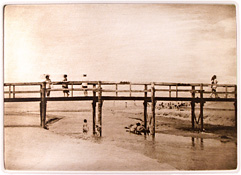Sarah Dunant’s novels of religious and political intrigue bring the 16th-century Medici era to marvelous life. The Birth of Venus sets Medici opulence against Savonarola‘s preachings of imminent damnation, in a story of forbidden love between a novice nun-to-be and a young artist. Sacred Hearts relates the story of another girl unwillingly sent to a convent, delirious with rage at her incarceration, whose saintly devotion to heavenly music eventually brings her and the convent a sort of peace. The world of the Renaissance is strangely familiar to us, and Sarah Dunant knows why.
She writes about the contradictory apocalyptic visions that trouble us today: One version of the contemporary apocalypse tells us that the only way out of the black hole of debt is to spend more, lest eternal stagnation and misery engulf us all. Another version tells us that economic growth itself is destroying the planet, that the oceans will rise, tempests will rage, the very climate and atmosphere of the planet will turn malevolent if we don’t mend our ways. No one except Sarah Dunant seems to have noticed that these two versions of hell are diametrically opposed and mutually exclusive.
The Medici era which gave rise to modern banking 500 years ago was also, by no coincidence, beset by visions of impending doom, especially for those engaged in the idolatrous pursuit of money for its own sake. The succeeding centuries have witnessed a seemingly endless sequence of apocalyptic visions, heralded by a collision of the sun with the earth (1603), the passage of comets (1719 and 1910), earthquakes (1805), planetary conjunctions (1919), and Orson Welles’ War of the Worlds radio broadcast (1938). And who can forget Y2K, the year when a couple of missing digits would doom everything from banking to air traffic control.
Of the various forms taken by popular fear, Dunant writes:
It is almost Darwinianly protean in the way it changes shape — from the four horsemen, through fears of nuclear destruction after World War II, to the contemporary debate about the raping and over-heating of the planet. For those who passionately believe it, the difference between this scenario and apocalyptic fears of the past is that those were misguided, but this one is correct.
History suggests, though, that each age begets its own sort of anxiety, related more to conditions here on earth than in the heavens. The dates often coincide with times of impending warfare, extreme deprivation, or revolutionary conflict. Every apocalypse features punishment of the wicked amid massive destruction, followed by the reign of the few who are saved. In earthly terms, they may be viewed as implicit threats against the elites of the day, warning them of the limits of their power.
Perhaps hellfire and damnation restrained the avarice of the first bankers. Back when usury was a mortal sin, the Scrovegnis (14th-century) who had

Giotto, Last Judgment
profited from it sought to redeem themselves with the gorgeous art of Giotto. Today’s financiers, lacking the exquisite taste of their predecessors, prefer to flaunt their wealth with guilt-ridden auction-certified dreck. In an odd reversal of the ancient apocalyptic message, the order of the day is opulence for the super-rich and restraint for the rest of us.

Hellfire (detail of Giotto fresco)
Sarah Dunant expresses perfectly the confusion of contemporary mixed apocalyptic messages:
But what has happened this year — which I think goes some way to explaining the confusion and despair that many of us have been feeling — is that we have basically experienced two potential apocalypses colliding. While on the one hand we are being told that if we are to save our planet we simply cannot go on exploiting its resources and must drastically reduce our levels of consumption – we are also being told that in order to pull ourselves out of the nightmare of spiraling recession, we must have growth and that growth depends on continued spending and consuming, i.e. more credit and more debt. I can’t be the only one, who while listening to these two voices simultaneously, has experienced mental vertigo.
She ends by quoting the eminent philosopher Woody Allen:
More than any time in history, mankind faces a crossroads. One path leads to despair and utter helplessness, the other to total extinction. Let us pray we have the wisdom to choose correctly.
As the history of apocalypse suggests, it might be wise to seek inspirational visions in everyday life here and now rather than in the hereafter. Depriving oneself indefinitely of the little pleasures of everyday life actually impoverishes that life rather than enriching it. Such things as a glance at a favorite print, the discovery of something new in a familiar image, the caress of the eye across the textured surface of a hand-made object, remind us that all happiness is fleeting, but not on that account to be put off indefinitely.
Real wealth consists in the accumulation of a lifetime of little impressions, chance meetings, journeys through the unexpected, memories, and perspectives developed from art and music, science and engineering, literature and philosophy. Denying oneself the visual resources to do this is simply false economy. Especially in times of distress, bold acts of imagination are required to create a future different from the present. Original artwork presents us with imaginary alternatives contrary to the apocalyptic nightmares we are immersed in, and in so doing helps to realize more benign visions of our future. That is my mission at The Kamakura Print Collection and kamprint.com/xpress/

Renaissance city Urbino

